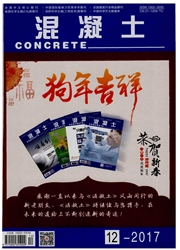

 中文摘要:
中文摘要:
通过混凝土吸水量试验、氯离子电通量试验及结合扫描电子显微镜观察混凝土微观结构,分别探究了掺入硅烷偶联剂、竹纤维以及两种材料混合掺3种不同掺入方式对早期混凝土防水性能和抗氯离子渗透性能的影响,并深入研究了两种材料影响早期混凝土渗透性能的原理。研究表明,硅烷偶联剂与混凝土发生化学反应,提高了早期混凝土的防水性能和抗氯离子渗透性能,当其掺量为2%时,混凝土的抗渗性能较好;掺入大量的竹纤维,导致混凝土内部结构疏松,显著降低了早期混凝土的防水性能和抗氯离子渗透性能;两种材料复掺仍然降低了早期混凝土防水性能和抗氯离子渗透性能,但比仅掺竹纤维时有所改善。试验方法和数据结果可为研究混凝土耐久性并运用于实际工程提供理论依据。
 英文摘要:
英文摘要:
The analyzing water vapor absorption experiments, electric flux test and SEM experiment with 3 different contents - only adding silane coupling agent into the concrete, only adding bamboo fiber into the concrete and adding the mixture of those two into the concrete were be done.These experiments were to explore the influences on water -proof and resistance to chloride ion permeability of the early concrete.And the principles of those two materials'influences on early permeability of concrete were deeply studied. The re- search indicate that silane coupling agent would have chemical reactions with concrete, thus, it improved early water - proof and early resistance to chloride ion permeability of concrete,when the mixing amount was 2%, a good permeability resistance was shown for the concrete. When adding a lot of bamboo fiber,it would result in the loose of internal structure of concrete, therefore, it would reduce the early waterproof and early resistance to chloride ion permeability of concrete; and when adding the mixture of silane coupling agent and bamboo fiber, there was also a decrease in early waterproof and early resistance to chloride ion permeability of concrete, but better than only adding bamboo fiber into concrete. All in all, the experimental methods and dams in this research can provide a theoretical basis for the study on the durability of concrete and the application in the practical engineering.
 同期刊论文项目
同期刊论文项目
 同项目期刊论文
同项目期刊论文
 Influence of Subjection to Plasma Nitriding Surface Modifications on Ultra-high Cycle Fatigue Behavi
Influence of Subjection to Plasma Nitriding Surface Modifications on Ultra-high Cycle Fatigue Behavi 期刊信息
期刊信息
